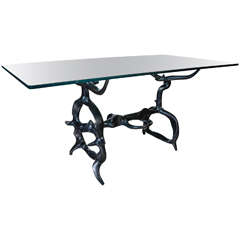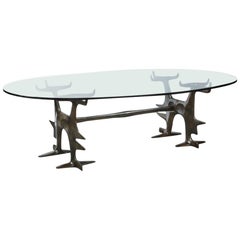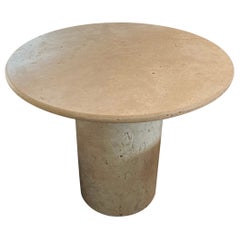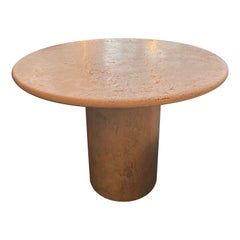Victor Roman Dining Room Tables
to
1
Height
to
Width
to
Depth
to
2
1
1
1
1
1
1
2
2
2
2
2
2
1
1
9
147
142
115
112
Creator: Victor Roman
Dining Table or Large Console by Victor Roman
By Victor Roman
Located in Bois-Colombes, FR
Bronze table base designed in 1974 by Victor Roman.
Signed, numbered 3/8 and stamp of the foundry.
Category
1970s French Vintage Victor Roman Dining Room Tables
Materials
Bronze
$29,807 Sale Price
28% Off
1970 "Araignée" surrealist bronze table by Victor Roman
By Victor Roman
Located in Paris, FR
Cast bronze table with surrealist shapes.
Model signed and numbered.
Limited edition of 8 + 4 AP of a model created in the 1970's by the sculptor Victor Roman.
Victor Roman was born in 1937 in Martinis in Romania. In 1950, he leaves his village to to go high-school in Tirgu-Mures. He then studies at the Fine Arts Institute Nicolae Grigorescu...
Category
21st Century and Contemporary French Victor Roman Dining Room Tables
Materials
Bronze
Related Items
White Roman Travertine Dining Table by Le Lampade
Located in Sag Harbor, NY
White Roman travertine bistro table by Le Lampade.
Round travertine top supported by a travertine column shaped base. These tables can be custom made.
Category
2010s Italian Modern Victor Roman Dining Room Tables
Materials
Travertine
White Roman Travertine Dining Table by Le Lampade
Located in Sag Harbor, NY
White Roman travertine bistro table by Le Lampade.
Round travertine top supported by a travertine column shaped base. These tables can be custom made.
Category
2010s Italian Modern Victor Roman Dining Room Tables
Materials
Travertine
Roman Deco Dining Table designed by Paolo Barracchia c. 1984
By Paolo Barracchia
Located in New York, NY
Exceptional, voguish, chic, and impressive Hollywood Regency style dining table designed by Paolo Barraccheli, made in Italy for Roman Deco, circa 1984. The table features rare and...
Category
1980s Italian Hollywood Regency Vintage Victor Roman Dining Room Tables
Materials
Brass
White Roman Travertine Coffee Table by Le Lampade
By Angelo Mangiarotti
Located in Sag Harbor, NY
White Roman travertine table by Le Lampade. Measure 18.25'' height x 41''' diameter
Round travertine top supported by a travertine column shaped base. These tables can be custom made.
Category
2010s Italian Modern Victor Roman Dining Room Tables
Materials
Travertine
White Roman Travertine Dining Table by Le Lampade
Located in Sag Harbor, NY
White Roman travertine bistro table by Le Lampade.
Round travertine top supported by a travertine column shaped base. These tables can be custom made.
Category
2010s Italian Modern Victor Roman Dining Room Tables
Materials
Travertine
Cityscape Multifaceted Dining Console Table Paul Evans
By Paul Evans
Located in Atlanta, GA
One of the most striking designs from Cityscape series by Paul Evans, this multifaceted table base from PE 300 series features a combination of brass and walnut burls panels and indi...
Category
1970s American American Craftsman Vintage Victor Roman Dining Room Tables
Materials
Brass
Flip-Top Burl Wood Dining Large Console Table Deco Figural Base
By Gilbert Rohde
Located in Rockaway, NJ
Mid-Century Modern deco base flip-top expandable console dining table. Beautiful honey amber tone finish.
Category
20th Century American Mid-Century Modern Victor Roman Dining Room Tables
Materials
Walnut
White Roman Travertine Bistro Table by Le Lampade
Located in Sag Harbor, NY
White Roman travertine bistro table by Le Lampade. Measure: 43''.
Round travertine top supported by a travertine column shaped base. These tab...
Category
2010s Italian Modern Victor Roman Dining Room Tables
Materials
Travertine
1940s New Era Modernage Glass Console or Dinette Table Black Ebonized Oak Base
By Modernage Furniture Company
Located in St. Louis, MO
New era glass table made for Modernage, circa 1940. Thick glass top on pedestal of glass, ebonized oak and mirror. Appropriate height for dining or can be used as a console.
Category
1940s American Mid-Century Modern Vintage Victor Roman Dining Room Tables
Materials
Cut Glass, Mirror, Oak
$2,400
H 29.5 in W 40 in D 26.5 in
Bronze Dining Table T14 by Peter Ghyczy, 1970s
By Peter Ghyczy
Located in Leuven, Vlaams Gewest
Impressive square glass dining table with cast bronze legs designed by Peter Ghyczy.
The thick glass top is supported in the corners by th...
Category
1970s German Brutalist Vintage Victor Roman Dining Room Tables
Materials
Bronze
Karl Springer Console Dining Table Authenticated
By Karl Springer
Located in Atlanta, GA
Pair of authenticated tulip table bases designed and manufactured by Karl Springer, Ltd. The bases are currently configured as a pair of console tables with glass tops, but they can ...
Category
1970s American Modern Vintage Victor Roman Dining Room Tables
Materials
Brass, Stainless Steel
Patinated Bronze Octopus Table or Sculpture, 1970s Italy
Located in Almelo, NL
Patinated Bronze Octopus Table or Sculpture, 1970s Italy
This fabulous dining table in the shape of an octopus is made in Italy. The base of the table i...
Category
1970s Italian Hollywood Regency Vintage Victor Roman Dining Room Tables
Materials
Glass
Victor Roman dining room tables for sale on 1stDibs.
Victor Roman dining room tables are available for sale on 1stDibs. These distinctive items are frequently made of metal and are designed with extraordinary care. There are many options to choose from in our collection of Victor Roman dining room tables, although gray editions of this piece are particularly popular. We have 1 vintage editions of these items in-stock, while there is 1 modern edition to choose from as well. If you’re looking for additional options, many customers also consider dining room tables by Pierre Chapo, André Arbus, and laura gonzalez. Prices for Victor Roman dining room tables can differ depending upon size, time period and other attributes — on 1stDibs, these items begin at $27,723 and can go as high as $70,083, while a piece like these, on average, fetch $48,903.



